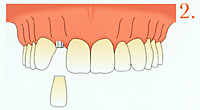Tomorrow’s Final Solution Today…
What are dental implants?
Dental implants are substitutes for natural tooth roots. The implants are secured in the position of a lost tooth. The supported replacement teeth look, feel and function like original teeth.
What do dental implants do?
Dental Implants:
- can provide single or multiple non-removable tooth replacements
- can provide support to fasten a full denture, making it more secure and comfortable
- will support a fixed cemented bridge, eliminating the need for removable partial dentures
- can assist in the replacement of a tooth without the need to alter adjacent natural and healthy teeth, therefore avoiding possible bridgework
What are the benefits of dental implants?
- Improved appearance – dental implants look and feel like your own natural teeth
- Improved comfort – dental implants eliminate the pain and discomfort associated with full or partial removable dentures
- Improved speech – dental implants preserve the integrity of the mouth, eliminating poor phonetics and allowing you to speak in a natural tone
- Dental implant can restore chewing capability, allowing you to eat your favorite foods without thinking twice about it
- Protect your remaining natural teeth- dental implants provide the benefit of avoiding the preparation of adjacent healthy teeth for bridgework
How do I know dental implants are right for me?
We can help you decide if a dental implant is right for you. First, we will review your medical and dental history, thoroughly examine oral tissues and supporting bone structure and check the way your teeth fit together when you bite. X-rays and models of your teeth may be taken and analyzed. After careful examination, we will talk with you regarding dental implant options. At that time, you should discuss the benefits, risks and possible treatments.
What is the success rate?
According to the most recent studies published by the American Academy of Periodontology and the International College of Oral Implantology, the long-term findings indicate success rates in the 95-99% region.
The Treatment Steps:
- The first step is the placement of the titanium implant. The implant will remain covered underneath the gum for approximately 3 to 6 months. During this time, the implant should fuse to the bone.

- The second step of the procedure involves uncovering the implant and attaching a post. This completes the foundation on which your new tooth will be placed. In some instances, your surgeon may decide to place the post at the time of the initial surgery.

- The final step is the placement of your new tooth by your dentist. With techniques that ensure optimal size, shape, color and fit, this replacement tooth should blend with your remaining teeth.

What One Tooth Can Restore:
A missing single tooth surrounded by healthy teeth has unique demands. The challenge is to replace your missing tooth for both function and appearance, without harming your remaining teeth or gum tissue.
Appearance
Besides good function, the ideal replacement must look like a natural tooth, both to you and to others. The solutions possible with an implant supported crown take advantage of the best appearance possibilities available in dentistry.
Confidence
The ideal replacement for your missing tooth must also feel like a natural tooth and be easy to keep clean. Knowing your tooth is stable while eating and talking means a lot. You’ll also be glad your treatment didn’t require grinding your remaining natural teeth.
Security
The long term safety of single-tooth replacement is well established. Your doctor will discuss with you a treatment plan for long term results.
The hope of restoring something important that’s been lost, especially in the human body, is an exciting possibility. With implants, it’s not just a hope. It’s a reality.
Our Range of Solutions:
- Single Tooth Replacement
- Posterior Replacement
- Anterior Replacement
- Full Lower Replacement
- Full Upper Replacement
